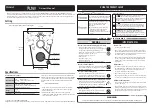
Liquiphant M/S with FEL56 and Nivotester FTL325N
Hauser
5
Structure of the measuring system
Level limit measuring system
The measuring system's devices are displayed in the following diagram (example).
A0022173
1
FEL - Electronic insert
A
Nivotester FTL325N (one-channel)
2
Liquiphant M/S
B
Nivotester FTL325N (three-channel)
Safety function
The safety function applies to all settings in MIN safety (monitoring of the covered state) and use of
the NO contacts of the level relays.
The following settings are permitted for the safety function:
The level relay always works in quiescent current safety; i.e. the relay releases when:
• The switch point is undershot (level falls below response height)
• A detected fault occurs
• The mains voltage fails
In addition to the level relay, the alarm relay works in quiescent current safety and releases when:
• One of the following faults occurs:
– the sensor connection is interrupted
– the sensor connection short circuits
• The mains voltage fails
[Ex ia]
CH1
CH1
FTL325
T
[Ex ia]
CH1
CH2
CH3
CH1
CH2 CH3
T
FTL325
A
B
1
2
Device
Setting
As-delivered state
Liquiphant
• Density switch setting: 0,5
• Density switch setting: 0,7
Density switch setting: 0,7
"MIN" safety
"MAX" safety
Nivotester
FTL325N-#3#3
Error current signal > 2,1 mA
Error current signal > 2,1 mA
All settings
except
"
S function" (see section "Settings and instal-
lation instructions")
Three-channel operation
The DIL switch for fault messaging
(short-circuit-, and circuit break-monitoring)
must be set to the ON position.
Failure switch "ON"
Nivotester
FTL325N-#1#1
Error current signal > 2,1 mA
Error current signal > 2,1 mA
One-channel operation
The DIL switch for fault messaging
(short-circuit-, and circuit break-monitoring)
must be set to the ON position.
Failure switch "ON"
When the alarm relay releases, the level relay also releases.






































